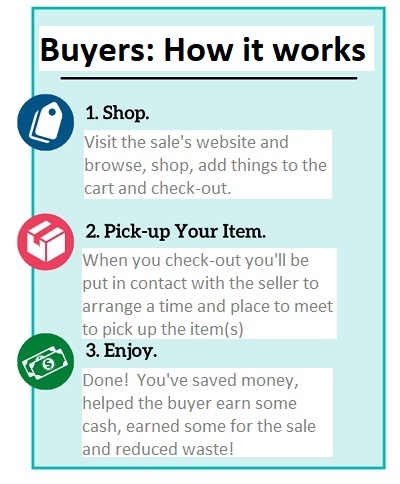
What is a Virtual Consignment Sale?
With fear of COVID-19 showing no signs of abating, some consignment sales are turning to "virtual" events. But what, exactly, is that and how does it work?
Of course, it depends on your perspective. See below for both buyers and sellers perspectives of how it works.
And there are advantages and disadvantages.
From a Buyers Perspective!
A virtual consignment sale or online sale is something like an online swap meet.
The sale organizer, located in a specific geographic area, creates a platform, just like the physical consignment sale, where you can see the merchandise, the price and even ask questions about it, the arrange with the seller where to meet, after purchasing it on the website.
Since the sale has a real physical location, both sellers and buyers are presumed to be conveniently located to each other, in the same area.
As a buyer, you create an account on the consignment sale's website, including a payment method (credit card, debit card, PayPal, etc.).
You shop for items, putting them in your shopping cart.
Check-out, and either:
- the sale will put you in touch with the seller(s) to arrange a place to meet to pick up the items
OR - In some virtual sales, the seller tags and drops off the items that sold at a central location (the sale's physical building, like a church). Volunteers use the tags to put together a package for each buyer of their items from all buyers and the buyer comes to pick them up there.
Advantages:
- You can do all the browsing and buying online at home (or anywhere you have an internet connection)
Disadvantages
- If you buy items from 10 different sellers you may have to make 10 trips or go to 10 locations to pick everything up.
- You can only look at photos and the buyers' description, you can't physically inspect things before purchase.

From a Seller's Perspective
As a seller, you
- create an account on the consignment sale's website, enter your items, with a description, photo that you can take with your phone, tablet or webcam, set the price, what to do with unsold items (discount/donations/return) and whatever things the sale asks,
- after the items sell, either:
- the sale puts you in touch (email, text, phone) with the buyer and you arrange a time and place to deliver the items to them.
Obviously, you use some common sense and meet in a public safe place, like in front of a busy grocery store or police station.
OR - you tag and drop off the items that sold at a central location (the sale's physical building, like a church). Volunteers use the tags to put together a package for each buyer of their items from all buyers and the buyer comes to pick them up there.
- the sale puts you in touch (email, text, phone) with the buyer and you arrange a time and place to deliver the items to them.
Obviously, you use some common sense and meet in a public safe place, like in front of a busy grocery store or police station.
Advantages:
- You enter everything online, just like in the physical model, but there is no need to print out tags and attach them to each item (unless the sale's approach requires you to bring the items to the sale location for pickup by the buyer - but even then, you only tag the items that sold.)
- No hangers and pins for the clothing
- There is no need to go pick up unsold items
Disadvantages
- If you sell items to 10 different buyers you may have to make 10 trips or go to 10 locations to deliver everything - unless the sale's approach has you to bring the items to the sale location for pickup by the buyer
- Usually you can only have one picture can be used per listing but if you would like to show your item at different angles or the front and back, etc. you can use an app like pic collage
Sewing Kit - Mend Your Clothes with this hand Sewing Kit w/case, with Buttons, Seam Ripper, Tweezers, Needle Threaders, 24-Color Polyester Threads, 30-Assorted Needles, Stainless Steel Scissors and more
Singer 4423 Heavy Duty Sewing Machine. With Accessory Kit, 97 Stitches. It's Simple, Easy To Use & Great for Beginners

Sewing Kit - Thread, Case, Supplies, Accessories, Tailor Scissors, 43XLSpools of Thread, 30 Needles, 200pcs